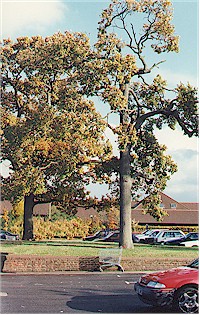 Deadwood
Deadwood Deadwood
Deadwood
Deadwood is an arboricultural term normally used to describe the presence of dead-branches located within a living trees crown. A common arboricultural procedure is 'dead-wooding' or to 'deadwood a tree' where such dead branches are removed.
Branches can die for a number of reasons. Many die as a natural process of becoming shaded out by other, higher, more efficient branches (it is pointless maintaining a branch laden with leaves if they can not receive sufficient light to manufacture foods). Many branches die due to root damage; this is a common problem on development sites where identifiable symptoms in the larger trees may not appear for several years. Or, the tree may be experiencing attack from a disease where either the branch itself has been directly harmed or the branch is reacting to a root or trunk attack.
Safety
A dead branch will at some point decay away completely back to the parent stem. This is normally a gradual process where the wood decays into a soft, crumbly state and slowly falls as small pieces. However, sometimes, and especially in windy conditions, larger pieces can fall which could cause injury or damage. For this reason deadwood is normally assessed as a safety hazard and depending upon the situation, removal may be recommended. Situations that demand such removal would normally be trees that overhang public roads, houses, public areas and gardens etc. Trees located within wooded areas are normally assessed as a lower risk but such assessment would need to consider the level of visitors. Normally, in these situations only trees adjacent to footpaths and access roads are considered for deadwood removal.
[Photograph: Two Oak trees experiencing problems due to root damage caused by the recent construction of a shopping centre car park (note the change of levels). The severance of roots means that the required level of water & nutrient resources are reduced, causing die-back of foliage within the crown; this produces dead branches (see Oak on right).]
Deadwood is usually classified as being Major Deadwood or Minor Deadwood. Major deadwood is specified as dead branches with a diameter exceeding 50-75mm (2-3 inches). It is generally these larger sized branches which are considered a safety hazard so it is normally only these which are removed. The removal of the smaller diameter minor deadwood is generally uneconomical especially since there is likely to be a large quantity within a typical tree. If contracting an arborist to remove deadwood it is important to clarify with him/her the size of deadwood to be removed so you don't pay for unnecessary works.
Benefits
Deadwood is a naturally occurring material which has a very important role in a woodland ecosystem. Many species of bird, insect, and fungi need the resources that deadwood provides. The need of some species is so great that they would become extinct if deadwood was made unavailable to them. Different species make use of different types of deadwood and some species will only use the deadwood whilst it is attached to the tree, high up in the canopy; once the wood has fallen to the woodland floor a different species may take over.
As the deadwood becomes broken down within the leaf litter, valuable nutrients are returned to the tree through the soil. This is an important natural process and one which is absent from most of our urban trees. Mulching with bark or wood chips, is however, becoming more popular but this usually just consists of a small mulched area located directly around a tree stem which is a poor substitute for the richness of a woodland floor.
Management
In woodland areas retention of deadwood both within the canopy and on the ground should be encouraged. This may however, be difficult in some situations so a compromise needs to be established. Most woodlands with public access will have dangerous deadwood removed from main footpaths and access roads. The same method could be applied to a large woodland garden where all members of the family are educated to the reasons for retention.
Dead branches can be stacked into small log piles within the woodland or garden to encourage insects and small mammals. Many gardeners shy away from retaining large pieces of wood on the ground in case they should attract the attention of Honey Fungus. However, Honey Fungus is a natural element of a woodland, it has an important role to degrade and rot wood; unfortunately it will also attack sick trees. For this reason it is usually best to avoid retaining old stumps and large pieces of wood within a formal garden which contains a number of specimen trees but instead reserve them for a woodland area.
© 2001 Chris Skellern. AIE. Home | News | A-Z Index | Resources | Contact AIE | Terms of Use